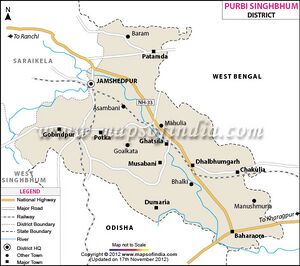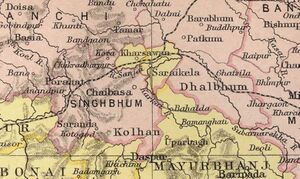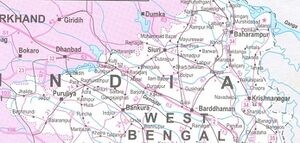Dhalbhumgarh
| Author:Laxman Burdak, IFS (R) |

Dhalbhumgarh (धालभूमगढ़) is a town and block in in the Ghatshila subdivision of East Singhbhum District of Jharkhand State, India.
Variants
- Dhalbhum (धलभूम)
Location
Dhalbhumgarh borders West Bengal and Orissa. The town is on NH-33. There is a railway station.
Origin of name
- Dhal (ढाल)
Jat clans
Following Jat clans have similarity with places shown in bold in this tahsil/block. There is need to further research this correlation.
Villages in Block Dhalbhumgarh
Amadubi, Amda, Asanbani, Babaida, Baghjata, Baghuasoli, Bagulakhas, Bagulatolajahirdang, Bagulatolakochabil, Baliaposi, Bamnisol, Bangarkolakhas, Bangarkolatola, Banskatiya, Basajhor, Behra, Bhaduakhasupertola, Bhaduatola, Bhairavpur, Bhakhar, Bhalkikhas, Bharudih, Bihinda Khas, Bihinda Tola 1, Burudih Khas, Burudih Tola, Chaksol Khas, Chaksol Tola 1, Chaksol Tola 2, Chaksol Tola 3, Charchakka, Chhabisa, Chirugora, Choira, Choira Tola 1, Chotro, Dalki, Dedang, Devsol, Dhadhkibani, Dobha, Dongadah Tola, Dongra, Dudhchuwa, Dudhposi Khas, Dudhposi Tola, Duliapara, Dumarbandhi, Ektal, Ghasidih, Ghoradhua, Ghoratoriya, Ghoshda, Gobrabanda, Gobraduma, Goglo, Gorabanda Khas, Gorbanda Tola, Gura, Gurgaicocha, Haldajhuri, Hariapata Khas, Harindhukri, Hariyan Khas, Hariyan Tola, Hatibari, Hatiyapata 1, Jagarnathpur, Jamua, Jarsol Tola 1, Jiyan, Jorsol, Jorsol Tola 2, Jugisol Khas, Jwalkta , Kakurrama, Kanderbera, Kandrapara, Kanimahuli, Kanyaluka, Karuwakata, Kasiyabera, Kendbani, Kendbanitola, Kharbandha, Khariybanda, Khejurdhari, Kudiyan, Kukrakhupi, Machhbhandar 1, Machhbhandarkhas , Maheshpur 2 , Mahisadhara, Makri, Manikabera, Maudasoli, Mohanpur, Muchhrisol, Murakati 1, Murathakura, Nagrapal, Naldhuwa, Namolepo, Nawadih 1, Nawagram, Nekrasoli, Nischintpur, Nuwagram, Paharpur, Palasbani, Panduda, Panijiya, Pariasol, Patgasoli, Patnayaksol, Phuli Khuta, Punisa, Raghunathdih 1, Rajabera, Reruwa, Romasoli, Ruwasol , Samka, Sarangsol, Sarbila, Sidhesol, Singhpura Khas, Sirishbani, Sonakhun, Sunderdih, Sundisol, Surgi, Swargchhira, Talgoglo, Taraspur, Tetuldanga, Tikrapara, Tilabani, Ukarbhal, Ulda, Upersoli Khas, Upersoli Tola,
History


Dhalbhum (Hindi:धलभूम,Bengali: ধলভূম) was the name given to parganas Supur and Ambikanagar in the Khatra area of present Bankura district in West Bengal.[1] In the course of time, Dhalbhum kingdom spread over a much wider area, across the western part of adjoining Midnapore district and the eastern and south-eastern parts of Singhbhum district in present-day Jharkhand.[2]
Dhalbhum was first written about when the British Army attacked the Dhalbhum and Ghatsila region in 1767 jointly with Raja of Midnapore, after a previous abortive attempt in 1765. The campaign against Dhalbhum was led by John Fergusson, who launched an attack on Ghatsila from Jambuni, defeating the local king and destroying Narsingarh Fort. The King was taken captive and deported to Midnapur. His nephew Jagannath Dhal was placed on the throne on the condition that he would pay a yearly sum of Rs 55,000 to the British Government. But, Jagganath found it tough to cope with the demands, as a result of which he was replaced by Baikund Dhal. This did not deter Jagganath, who attacked King Baikund. Finally, he was reinstated on the condition that during the first year of his reign, he would pay tax of Rs 2000, in the second year Rs 3000 and in the third year Rs 4000. In 1800, rent of Rs 4, 267 was fixed, which was to be paid by the Kingdom. In 1845 the region was incorporated into the Singhbhum District. Following this, in accordance with 1848 Regulation Act, Singhbhum District was converted into a non-regulation district under the Governor of Bengal.
According to tradition, the original Raja of Dhalbhum was Chintamoni Dhoba. The pai or grain measure used in these parganas was for a long time called Chintaman pai. Legend goes on to say that Dhalbhum was wrested from him by Jagannath Deb of Dholpur in Rajasthan.
After 32 generations Supur Raj, as it was locally called, was divided in consequence of a disputed succession. One of the successors continued at Supur and the other shifted to Ambikanagar. Both the families were related to the families of Bishnupur, Raipur, Shyamsundarpur and others.[3]
They ruled for about 700 years. A branch of the same family ruled in Chikligarh or Jamboni.[4]
Rankini Devi is established as the family goddess of the Dhalbhum rulers. It is said that human sacrifice was offered to the goddess every year. Ghosh, Binoy, Paschim Banger Sanskriti, (in Bengali), part II, 1978 edition, p. 56, Prakash Bhaban
According to Dr Naval Viyogi, It seems from the evidence of Puri Kushan coins that some branch Tanka of Taka royal family owing to attack of Kushanas up to Magadha, reached Mayurbhanj, Singhbhumi, Ganjam and Balasore and established colonies there, where remains of their offshoot, the royal family of Dhavaldev is still existing at Dalbhumigarh near Kharagpur. [5]
Jat History
Legend goes on to say that Dhalbhum was wrested from him by Jagannath Deb of Dholpur in Rajasthan.
धालभूमगढ़
धालभूमगढ़ (Dhalbhumgarh) भारत के झारखण्ड राज्य के पूर्वी सिंहभूम ज़िले में स्थित एक शहर और ब्लॉक-मुख्यालय है। राष्ट्रीय राजमार्ग-33 यहाँ से गुज़रता है ।
References
References
- ↑ O’Malley, L.S.S., ICS, Bankura, Bengal District Gazetteers, pp. 194-195, 1995 reprint, first published 1908, Government of West Bengal
- ↑ Ghosh, Binoy, Paschim Banger Sanskriti, (in Bengali), part II, 1978 edition, p. 56, Prakash Bhaban
- ↑ Ghosh, Binoy, Paschim Banger Sanskriti, (in Bengali), part II, 1978 edition, p. 56, Prakash Bhaban
- ↑ Ghosh, Binoy, Paschim Banger Sanskriti, (in Bengali), part II, 1978 edition, p. 56, Prakash Bhaban
- ↑ Dr Naval Viyogi: Nagas – The Ancient Rulers of India, p.158

